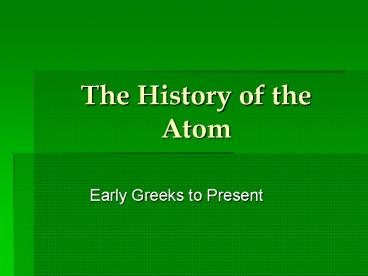The History of the Atom - PowerPoint PPT Presentation
1 / 22
Title: The History of the Atom
1
The History of the Atom
- Early Greeks to Present
2
Democritus (460 B.C.-370 B.C.) Greek
Philosopher
- Among the first to suggest the existence of
atoms. - Believed that atoms were indivisible and
indestructible. - No experimental support.
- Ideas not based on scientific method.
3
Aristotle (384 B.C.-322 B.C.)Greek Philosopher
- Believed all matter was made up of atoms.
- Gave matter the name hyle.
- No experimental data.
4
John Dalton (1766-1844)English Chemist and
School Teacher
- Used experimental methods.
- Transformed Democrituss ideas on atoms into a
scientific theory. - Responsible for Daltons Atomic Theory.
5
Daltons Atomic Theory
- All elements are composed of tiny indivisible
particles called atoms. - Atoms of the same element are identical. The
atoms of one element are different from those of
any other element.
- Atoms of different elements can physically
combine in simple whole-number ratios to form
compounds. - Chemical reactions occur when atoms are
separated, joined, or rearranged. Atoms of one
element are never changed into atoms of another
element.
6
J.J. Thomson (1856-1940) Excuse me... how can
you discover a particle so small that nobody has
ever seen one?
- 1897-English Physicist
- Discovered the electron.
- Used cathode ray tube experiment to explain his
theory.
7
Cathode-Ray Tube
8
Cathode Ray-Tube(Crookes Tube)
9
Cathode-Ray Tube Experiment
- Thomson performed experiments that involved
passing electric current thru gases at low
pressure. - He sealed the gases in glass tubes fitted at both
ends with metal disks called electrodes. - Electrodes were connected to a source of
electricity.
- Two ends of the tube
- 1. cathode- negatively charged electrode.
- 2. anode- positively charged electrode.
- Cathode Ray- glowing beam that travels from the
cathode to the anode.
10
Cathode Ray Tube Experiment Continued
- The beam traveled across the tube from the
cathode to the anode. - The beam was deflected by negative charges, but
was attracted to positive charges. - He concluded that the particles that made up the
beam must be negatively charged. He called them
electrons.
11
Plum Pudding Model
- J.J. Thomson proposed this model of the atom.
- Electrons were stuck into a lump of positive
charge, similar to raisins stuck in dough.
12
Robert A. Millikan (1868-1953)U.S. Physicist
- 1916- Calculated the mass of electron.
- Values for electron charge and mass reported in
1916 are very similar to those accepted today. - Electrons carry exactly one unit of negative
charge. - Electrons have a mass of 1/1840 the mass of a
hydrogen atom.
13
Eugen Goldstein (1850-1930)German Physicist
- Observed rays traveling in the direction opposite
to that of the cathode rays. - He called these rays canal rays and concluded
they were positively charged. - Now called protons.
- Mass of a proton is 1840 times that of an
electron.
14
James Chadwick (1891-1974)English Physicist
- 1932-Confirmed the existence of another particle
with no charge- neutron.
15
Ernest Rutherford (1871-1937)Student of Thomson
- 1911- Tested the theory of atomic structure using
the gold-foil experiment. - Suggested a new theory base on his results.
16
Rutherfords Gold Foil Experiment
17
Summary of Gold-Foil Experiment
- A narrow beam of alpha particles was directed at
a very thin sheet of gold foil (1 atom
thickness). - According to the previous theory, the particles
should have passed thru. - Most particles passed through and some of them
bounced back or were deflected.
18
Rutherfords Conclusions
- Atoms are made up of mostly empty space.
- Atoms have a positive center called a nucleus.
- Most of the mass of the atom is located in its
nucleus. - Improvement over the Plum-Pudding Model, but
still incomplete.
Plum Pudding Model
Rutherfords New Atom
19
Niels Bohr (1885-1962)Danish Physicist
Bohr debating Quantum Theory with Albert Einstein
20
Bohr Model of the Atom
- Planetary Model was correct.
- Electrons were in orbits around the positively
charged nucleus. - Based on Quantum Physics.
21
Electron Cloud Model
- Electrons are not in perfect orbits around the
nucleus. - Imagine, as the electron moves it leaves a trace
of where it was. - This collection of traces quickly begins to
resemble a cloud.
22
Thanks to the following Websites
- http//regentsprep.org/Regents/physics/phys05/cato
model/cloud.htm - www.wikipedia.com
- http//www.upscale.utoronto.ca/GeneralInterest/Har
rison/BohrModel/BohrModel.html - http//www.chemsoc.org/timeline/pages/1911.html































